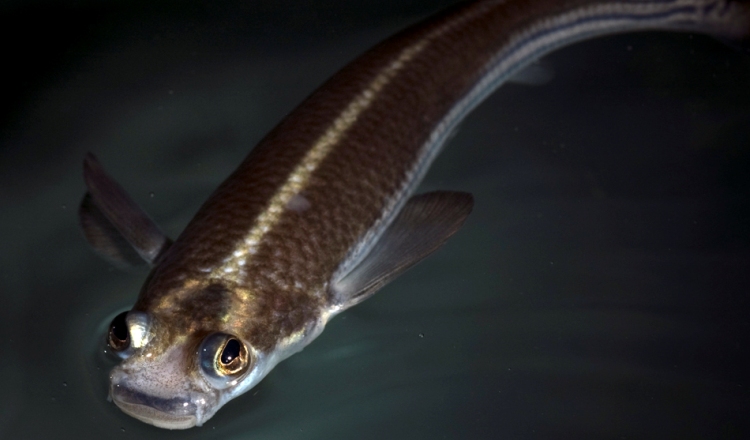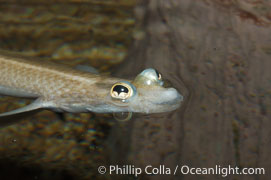
Anableps anableps
FAMILY
Anablepidae
TAXONOMY
Anableps anableps Linnaeus, 1758, India (misreported type locality).
OTHER COMMON NAMES
English: Striped foureyed fish, foureyed fish, foureye; Spanish:
Cuatro ojos; Portuguese: Quatro-olhos.
PHYSICAL CHARACTERISTICS
Grows to 12 in (30 cm) in total length. Elongate, compressed
posteriorly, and flat anteriorly. Blunt snout and toothy horizontal
mouth with only a slight curvature. Large, bulging,
froglike eyes set far forward, almost on the snout, and divided
by a black horizontal band into an upper and lower portion for
separately viewing above and below the waterline. Dorsal fin
set far back, completely behind the anal fin. Three to five blue
to violet horizontal lines of varying lengths run along the sides.
Dorsal surface is brownish. A whitish line runs along the back;
at the operculum the line divides into a Y shape, each arm of
which terminates at an eye. The ventral area is whitish. Sexually
dimorphic. Females are larger than males, with rounded
fins; males have a tubular, scaled gonopodium.
DISTRIBUTION
Trinidad, Venezuela, Guyana, Suriname, French Guiana, and
the Amazon Delta in Brazil.
HABITAT
Found in freshwater, brackish, and saltwater rivers, streams,
and estuaries and oceanic saltwater near beaches.
BEHAVIOR
A gregarious schooling fish, sometimes gathering in the hundreds
with congeners of equal size. Since they swim with the
upper half of their eyes above the water, they have the amusing
habit of bobbing their heads up and down so as to keep their
eyes wet. This species has been seen riding the breakers near
sandy beaches, sometimes getting tossed onto the beach by the
waves. Undaunted, foureyes just jumps back in. Because of
their acute vision above the water, they are very difficult to
capture.
FEEDING ECOLOGY AND DIET
In brackish and marine environments, scores of these fish jump
out of the water at low tides to gulp down the mud, which is
rich in algae, diatoms, dinoflagellates, amphipods, isopods, and
worms. Although they are primarily surface feeders, they leap
from the water in pursuit of low-flying insects. Small fishes
also are part of their diet, but these fish are not bottom feeders.
Not surprisingly, aquarists report that the species will not
take food that falls to the bottom of an aquarium.
REPRODUCTIVE BIOLOGY
Foureyes are live-bearers with internal fertilization and matrotrophic
(type 2) gestation and development. The male
gonopodium swings out in a horizontal plane, but only in one
direction, either to the left or to the right. The vent of the female
is covered by a hinged scale called a “foricula,” which
opens to the left or right. Thus, right-handed males must mate
with left-handed females and vice versa, an odd situation that
does not seem to impede their reproduction. The gestation period
is about 20 weeks, with a brood size of 10 to 20 fry. The
young are large, up to 2 in (5 cm) at birth. This large size is
remarkable, considering that sexual maturity is reached at
about 3.5 in (9 cm).
CONSERVATION STATUS
Not listed by the IUCN.
SIGNIFICANCE TO HUMANS
All species are taken for food in subsistence fishing, and, to a
limited extent, they are sold in the aquarium trade.
Photo Gallery of - Largescale foureyes





 Animalia Life
Animalia Life